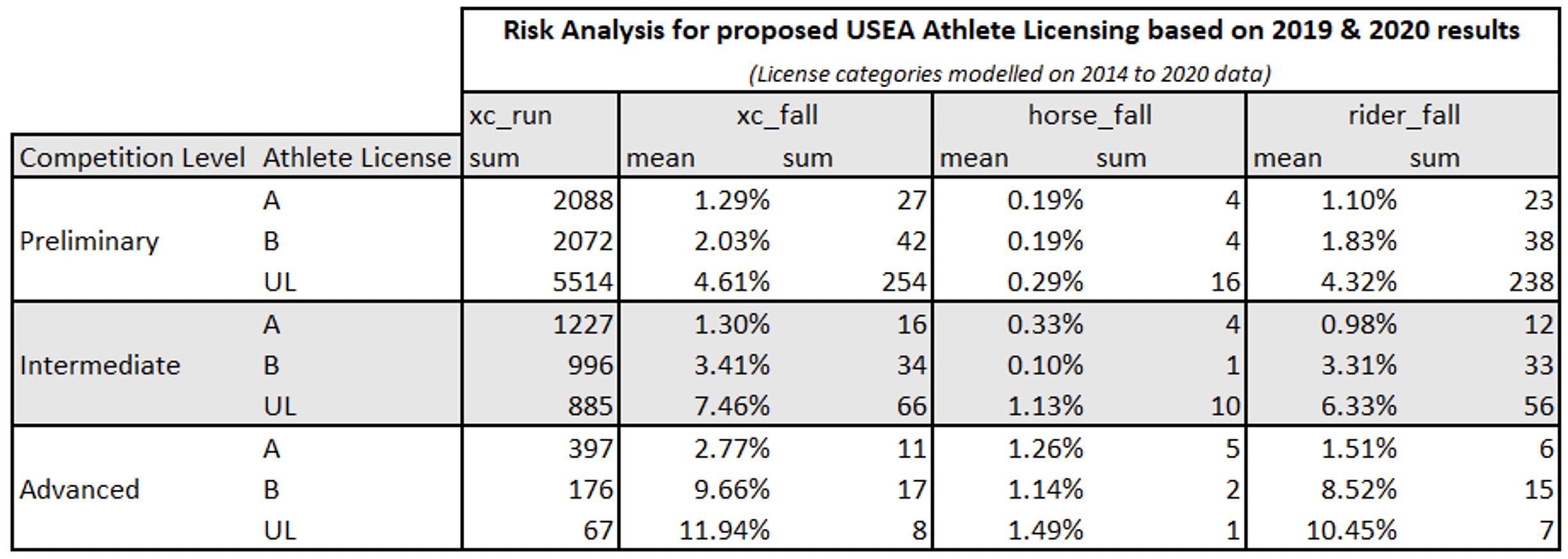For those asking for stats – you’ve confused me, there are stats in the original press release from USEA, here, and one of the relevant stats is that unlicensed rider chance of fall at prelim is 1 in 39 compared to A-rider stat of 1 in 349. Am I missing something?
https://useventing.com/news-media/news/update-on-appendix-3-rule-change-proposal (this link was posted very early on in this thread).
Following feedback from our membership to the rule change proposal for the USEF Rules For Eventing : Appendix 3 – Participation In Horse Trials, the United States Eventing Association (USEA) Board of Governors voted to modify the rule change proposal, but still to recommend the establishment of rider licenses and increase Minimum Eligibility Requirements (MERs) to the regulating authority of the sport US Equestrian (USEF).
The USEA Cross-Country Safety Subcommittee developed the original proposal after a review of serious injuries and fatalities in the sport. The consensus of the group was that the standards needed to be raised to earn the right to move into a higher level of competition. The MER numbers were based on best practices of top-level competitors in the sport as well as data analysis supported by the independent firm EquiRatings. The proposal passed from the Subcommittee to the USEA Board of Governors who made the decision to lower the requirements before it moves to US Equestrian (USEF).
Jonathan Holling, chair of the USEA Cross-Country Safety Subcommittee, spoke to the Board of Governors to explain further the proposal. “All of the officials I have spoken to agree that something needs to change,” said Holling. “When we came out last year with the frangible fence initiative one of the big things that was said to me early on and repeated loud and clear was that 'this is great, this is wonderful, but it isn’t going to solve the problem by itself.’ We need better riding through better qualifications, better coaching – all of it. While we realize that frangible fences are a huge piece of this, we have to have some sort of a rider license and increasing the qualifications going forward. I know that there have been some concerns about Areas that don’t have as many events and I hear you loud and clear, but just know on this committee there are a lot of people that come from all over this country – I am from Milwaukee, Wisconsin, we have Canadians, we have west coasters. The reality is that we have a responsibility to the sport of eventing to do the best we can to make it as safe as possible and I firmly believe this proposal we are putting in front of [the Board] does that.”
Dave Vos, member of the USEA Cross-Country Safety Subcommittee, an amateur eventer, and a highly experienced engineer, joined the call to explain the numbers and data collected by EquiRatings to the Board. “The statistics tell you what the picture is, and they tell us that we need to reduce the fall rate and therefore reduce the risk of serious falls happening,” said Vos. “While addressing risk is the main driver, we are also addressing the quality of riding throughout eventing in the United States and that goes very much hand in hand with additional experience, additional expertise, and additional training in order to move up the ranks. You build a much better foundation if you are way more proficient at Training before you go to Preliminary and so on. Where we are is that the numbers aren’t crazy different from what people are already doing, but they do encourage additional experience and training.”
*UL = Unlicensed
Based on the data prepared the following can be noted:
-
Preliminary level : Unlicensed riders (55% of all entries) are falling at a rate of 4.6% , compared to B riders (23% of all entries) at 2% , and A riders (22% of all entries) at 1.3%.
-
Intermediate level : Unlicensed riders (30% of all entries) are falling at a rate of 7.5%, compared to B riders (30% of all entries) at 3.4%, and A riders (40% of all entries) at 1.3%.
-
Advanced level : Unlicensed riders (10% of all entries) are falling at a rate of 12% , compared to B riders (30% of all entries) at 10%, and A riders (60% of all entries) at 2.8%.
The estimate of conditional probability of a fall given the new licenses yields:
- Likelihood of a fall at Preliminary given rider is unlicensed =1/(4.6/100)/(55/100) = 1 in 39
- Likelihood of a fall at Preliminary given rider is a B =1/(2/100)/(23/100) = 1 in 217
- Likelihood of a fall at Preliminary given rider is an A =1/(1.3/100)/(22/100) = 1 in 349
Before moving up to the Preliminary level riders are currently completing on average:
-
Unlicensed riders: 6 MERs (with a +/- 4 standard deviation)
-
B riders: 5 MERs (with a +/- 4 standard deviation)
-
A riders: 4 MERs (with a +/- 3 standard deviation)
So, a good number are already achieving the new requirements.

